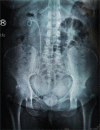Urinary bladder stone due to retained indwelling ureteral stent: A case report
- PMID: 32991432
- PMCID: PMC7523868
- DOI: 10.1097/MD.0000000000022293
Urinary bladder stone due to retained indwelling ureteral stent: A case report
Abstract
Rationale: The indwelling ureteral stents is a common procedure in routine urological practice. The double-J (D-J) stent is the most common type of stents used and is indicated mainly for short-term urinary drainage and prevention of obstruction and infection. However, prolonged indwelling stents may result in disastrous complications, such as hematuria, infection, encrustation, and stone formation. In this context, the persistence of stent in situ might play a key role as a nidus in deposition of urinary sediment, then forming calculus. Although the encrustation may become more serious as time goes on, large bladder stones are relatively rare. However, the serious encrustation and giant stone may complicate or exacerbate the conditions in turn.
Patient concerns: A 45-year-old female patient who underwent right ureteral stent placement after open ureterolithotomy 6 years ago complained of dysuria, urinary frequency, and urgency over 2 months.
Diagnosis: The kidney ureter bladder (KUB) x-ray showed the presence of a giant stone in the bladder and an entire D-J stent. The computed tomography (CT) urography scans revealed normal left kidney, right hydronephrosis, and an encrusted D-J stent with the significant stone, diameter 4.2 cm with a CT value of 1211.0 ± 221.6 HU, on the vesical coil. On the basis of these auxiliary examinations, the case was diagnosed as cystolith and prolonged-indwelling stents.
Interventions: Pneumatic ballistic lithotripsy was used for crushing the bladder calculi followed by the successful extraction of intact D-J ureteral stent.
Outcomes: No residual stone was detected on postoperative KUB x-ray and CT urography scans. Patient recovered well and was discharged 10 days after surgery. Semi-annual ultrasound examination was suggested to monitor the effect of therapy.
Lessons: This case reminds us that it is crucial to take various measures to avoid the forgotten ureteral stent and its unfortunate late complication.
Conflict of interest statement
The authors have no conflicts of interest to disclose.
Figures




References
-
- Ringel A, Richter S, Shalev M, et al. Late complications of ureteral stents. Eur Urol 2000;38:41–4. - PubMed
-
- Richter S, Ringel A, Shalev M, et al. The indwelling ureterk stent: a ‘friendly’ procedure with unfriendly high morbidity. BJU Int 2000;85:408–11. - PubMed
-
- Domiano R, Oliva A, Esposito C, et al. Early and late complications of double pigtail ureteral stent. Urol Int 2002;69:136–40. - PubMed
-
- Pais VM, Jr, Chew B, Shaw O, et al. Percutaneous nephrolithotomy for removal of encrusted ureteral stents: a multicenter study. J Endourol 2014;28:1188–91. - PubMed
-
- Singh I, Gupta NP, Hemal AK, et al. Severely encrusted polyurethane ureteral stents: management and analysis of potential risk factors. Urology 2001;58:526–31. - PubMed
Publication types
MeSH terms
LinkOut - more resources
Full Text Sources

